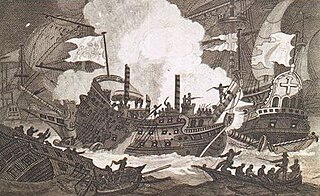 W
WGalleons were large, multi-decked sailing ships first used as armed cargo carriers by European states from the 16th to 18th centuries during the age of sail and were the principal vessels drafted for use as warships until the Anglo-Dutch Wars of the mid-1600s. Galleons generally carried three or more masts with a lateen fore-and-aft rig on the rear masts, were carvel built with a prominent squared off raised stern, and used square-rigged sail plans on their fore-mast and main-masts.
 W
WThe beeswax wreck is an as-yet-undiscovered shipwreck somewhere off the coast of the U.S. state of Oregon, near Neahkahnie Mountain and the mouth of the Nehalem River in Tillamook County. The ship, thought to be a Spanish Manila galleon that was wrecked in the late-1600s, was carrying a large cargo of beeswax, lumps of which have been found scattered along Oregon's north coast for at least two centuries.
 W
WDainty was an English race-built galleon that began to be built in 1588. The original name was Repentance, but this was soon changed. She participated in some naval engagements in the Anglo-Spanish War (1585–1604). In 1593 she sailed from England under Richard Hawkins to navigate the Pacific Ocean and circumnavigate the world, but was captured the following year by the Spaniards when she was sailing off the coast of what is now Ecuador. She was commissioned by the Spaniards as Nuestra Señora de la Visitación, serving in the South Pacific for several years.
 W
WGolden Hind was a galleon captained by Francis Drake in his circumnavigation of the world between 1577 and 1580. She was originally known as Pelican, but Drake renamed her mid-voyage in 1578, in honour of his patron, Sir Christopher Hatton, whose crest was a golden hind. Hatton was one of the principal sponsors of Drake's world voyage. A full-sized, seaworthy reconstruction exists in London, on the south bank of the Thames.
 W
WThe Golden Hinde is a full-size replica of the Golden Hind. She was built using traditional handicrafts in Appledore, Torridge. She has travelled more than 140,000 mi (230,000 km), a distance equal to more than five times around the globe. Like the original ship, she has circumnavigated the globe.
 W
WThe Manila Galleons were Spanish trading ships which for two and a half centuries linked the Philippines with Mexico across the Pacific Ocean, making one or two round-trip voyages per year between the ports of Acapulco and Manila, which were both part of New Spain. The name of the galleon changed to reflect the city that the ship sailed from. The term Manila Galleons is also used to refer to the trade route itself between Acapulco and Manila, which lasted from 1565 to 1815.
 W
WNuestra Señora del Rosario, was a Spanish first-rate ship of the line of the Kingdom of Spain's Armada Real in service between 1587 and 1588.
 W
WNuestra Señora de la Encarnación y Desengaño, nicknamed Desengaño, was a Manila galleon which plied the trade routes between the Viceroyalty of New Spain and the Spanish Philippines. The ship was captured on 22 December 1709 by a British privateering expedition led by Woodes Rogers and renamed Bachelor.
 W
WThe race-built galleon was a type of war ship built in England from 1570 until about 1590.
 W
WRawFaith was a wheelchair-accessible, wooden sailing vessel built and owned by George McKay in Maine, United States.
 W
WSan José was a 64-gun, 3-masted galleon of the Spanish Navy. It was launched in 1698, and sank in battle off the coast of Cartagena, Colombia, in 1708 while laden with gold, silver and emeralds worth about US$17 billion as of 2018. The sunken ship was located by the Woods Hole Oceanographic Institution (WHOI) in November 2015.
 W
WSan Juan Bautista was one of Japan's first Japanese-built Western-style sailing ships. She crossed the Pacific in 1614. She was of the Spanish galleon type, known in Japan as nanban-sen.
 W
WSan Salvador was a Spanish galleon of the Spanish Armada as part of the Guipúzcoan squadron of Miguel de Oquendo. She was damaged and captured as a result of the first encounter of the Armada with the Royal Navy in 1588. San Salvador was lost at sea in the English Channel later that same year.
 W
WThe São João Baptista, commonly known as the Botafogo, was a Portuguese galleon built in the 16th century, around 1530, considered the biggest and most powerful warship in the world by Portuguese, Castillian and Italian observers of the time.
 W
WSão Martinho or San Martín, built as a Portuguese Navy galleon, became the flagship of Duke of Medina Sedonia, commander-in-chief of the Spanish Armada.